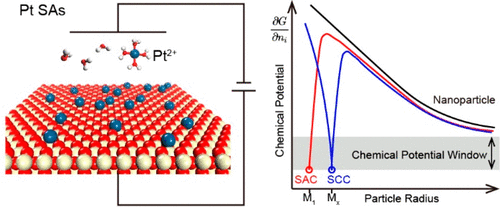当前位置:
X-MOL 学术
›
J. Am. Chem. Soc.
›
论文详情
Our official English website, www.x-mol.net, welcomes your
feedback! (Note: you will need to create a separate account there.)
Constructing High-Loading Single-Atom/Cluster Catalysts via an Electrochemical Potential Window Strategy
Journal of the American Chemical Society ( IF 14.4 ) Pub Date : 2020-01-29 , DOI: 10.1021/jacs.9b06808 Jin-Cheng Liu 1 , Hai Xiao 1 , Jun Li 1, 2
Journal of the American Chemical Society ( IF 14.4 ) Pub Date : 2020-01-29 , DOI: 10.1021/jacs.9b06808 Jin-Cheng Liu 1 , Hai Xiao 1 , Jun Li 1, 2
Affiliation

|
Single-atom catalysts (SACs) and single-cluster catalysts (SCCs) are the new frontier of heterogeneous catalysis, which exhibit high activity, selectivity, stability, and atomic efficiency, as well as precise tunability. However, the lack of efficient methods for producing high-loading and high-purity SACs and SCCs hinders their industrial applications. In this work, we propose a general and efficient strategy for the production of high-loading and high-purity SACs and SCCs anchored on suitable substrates. Our strategy relies on the existence of an electrochemical potential window we predict, within which that any aggregate forms of the target metal on the substrate are leached away by electrochemical oxidation, while the strongly bound single-atoms or single-clusters remain at the substrate. We demonstrate the applicability of this strategy with modeling the production of Pt, Pd, and Ni SACs anchored on N-doped graphene and Fe2O3, as well as Pt3 and Ni3 SCCs anchored on graphdiyne.
中文翻译:

通过电化学势窗策略构建高负载单原子/簇催化剂
单原子催化剂(SACs)和单簇催化剂(SCCs)是多相催化的新前沿,它们表现出高活性、选择性、稳定性和原子效率,以及精确的可调性。然而,缺乏生产高负载和高纯度 SAC 和 SCC 的有效方法阻碍了它们的工业应用。在这项工作中,我们提出了一种通用且有效的策略,用于生产固定在合适基材上的高负载和高纯度 SAC 和 SCC。我们的策略依赖于我们预测的电化学电位窗口的存在,在该窗口内,基材上目标金属的任何聚集形式都被电化学氧化浸出,而强结合的单原子或单团簇保留在基材上。
更新日期:2020-01-29
中文翻译:

通过电化学势窗策略构建高负载单原子/簇催化剂
单原子催化剂(SACs)和单簇催化剂(SCCs)是多相催化的新前沿,它们表现出高活性、选择性、稳定性和原子效率,以及精确的可调性。然而,缺乏生产高负载和高纯度 SAC 和 SCC 的有效方法阻碍了它们的工业应用。在这项工作中,我们提出了一种通用且有效的策略,用于生产固定在合适基材上的高负载和高纯度 SAC 和 SCC。我们的策略依赖于我们预测的电化学电位窗口的存在,在该窗口内,基材上目标金属的任何聚集形式都被电化学氧化浸出,而强结合的单原子或单团簇保留在基材上。

































 京公网安备 11010802027423号
京公网安备 11010802027423号